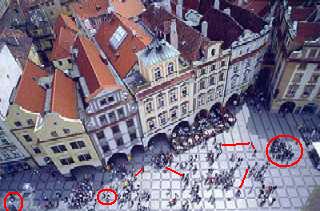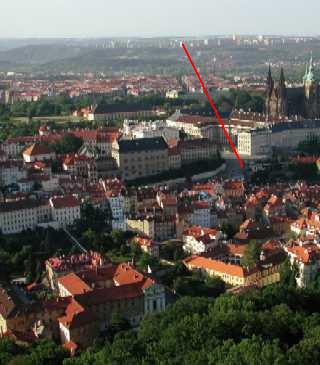
CMT: Prague is such a beautiful old city. Eastern in its feel. Communitarian, connected. You can walk everywhere, easily.
DSM: But western cities with their ethos of space and powerful cars driving along interstate highways or autobahns at high speeds can be uplifting, too. Melvin Webber called it ‘community without propinquity’. I lived in Houston for ten years. The effect of the city was such that I couldn’t help but feel connected to Los Angeles and New York and London and the whole world. That hyper-mobile city imparted a dream of achieving liberation through mobility, of finding freedom by defeating geographic constraints.
CMT: If I have an argument with the so-called ‘New Urbanists’ it is that they’re too ready to valorize the old city, and too ready to disparage developments of the past 100 years. They have certain legitimate points—objections to the sprawl and wastefulness and sterility of suburbs, for example. But they reject the legitimacy of the psychosocial desire for distance, or seek unilaterally to disenfranchise those of us who have such a need.
DSM: Scientists invent new words as they confront things that are not yet known; they need a language that enables them to talk about them. Foucault once said we inherently and continually need to invent ‘gray language’. We need to make new language to talk about the worlds we’re creating and revising and inscribing—this is what happens in other fields anyhow. It’s just not so common to acknowledge that this same need exists in music.
CMT: Henri Lefebvre used to say, “Urban space is defined as a place where people walk around, finding themselves standing before and inside piles of singular objects, experiencing the intertwining of the threads of activities until they become unrecognizable, entangled situations in such a way that they engender unexpected situations. The definition of this space consists of a null vector. The cancellation of distance haunts the occupants of urban space. They can’t avoid encountering each other.”
DSM: I could paraphrase Lefebvre on sub-urban space: “Suburban space is a domain where people drive around, and find themselves passing singular objects, experiencing activities that are entirely familiar and engaging in situations in such a way that they engender highly predictable situations. The definition of this space is that it has a manifold of vectors. Attenuated distances—abridged and compressed distances—haunt the occupants of suburban space. They scarcely encounter each other.”

CMT: That’s another kind of city. It superficially appears to be a scattered mélange of objects and motifs. But in fact it’s exceedingly organized, textured, perfectly striated, facilitated by mechanization and commerce. If Bob wants to visit Sue, their trip and discourse will be inscribed by the reality of the surrounding infrastructure and the types of activities that it is conducive to—will be inscribed by the roadways and the means of motivic transport that have been set up. He uses a car—or he uses a violin to navigate these Janáček figures.
DSM: At its heart is something that’s thoroughly modern and western. Because I was an engineer at one time, I’m trying to come up with an equation—we overcome distance by increasing our speed, and then we feel too close so we move farther apart, more or less keeping the time between us constant. But the range of how far we can go—the area we can cover in constant time goes up as the square of our maximum speed. So if we increase our speed by a factor of two, the scope of our connectedness is greater by a factor of four...
CMT: That view is, I think, a distinctly ‘American’ or ‘North American’ sense of distance, rather than your broader ‘Western’ characterization of it. Maybe ‘Australian’ and other cultures would own up to it too, but surely not all Western countries.
DSM: Any city or suburb is, in Lefebvre’s view, an interaction of distance and vectors. On one end of the spectrum, it’s crowded and intense and null vectors of negligible length. On the other end of the spectrum, it’s ‘dross space’, pure distance with infrequent interactions, desert-like, desolate.
CMT: There are megaforms, hypermeter, weather systems that are larger than the scale of any motif of composerly devise.
DSM: And there are speed-zones where larger motifs provide strong hints to the listener, as to how to interpret the music. Like a winding parkway through a residential area, or an esplanade with retail stores separated from the main trafficway by adjacent boulevards. There are parts of Paris and Lisbon like this...
CMT: Suburbia establishes this microcosm—an abstracted caricature of who we are. It invites us to ignore or neglect some features of the people and spaces around us. It tends to produce a toxic ecology whose consequences permeate other parts of society and extend to future generations. You can’t expect free-market forces to acknowledge or correct these effects. The private sector wants to make money and imagines that the public sector is there to facilitate commerce. The public sector often feels that it doesn’t have the remit—the authority and resources—to deal with it. But now things are happening in many places—the gentrification and revitalization of older areas—these are inner frontiers. Part of what I hear in Janáček.
DSM: But the upshot of this is that we are never fully ‘ourselves’ in any one environment. Our possibilities are always modulated by our context, by the stimuli that impinge on us. And we ourselves are like prisms. If we don’t seek out different stimuli, different contexts, different illumination—then we’ll have traversed in our lives only a narrow bit of the range, of the totality of who we are.
CMT: Townhouses and gated communities. Memorials to isolation and individualism. Janáček was taking some of those fences and gates down. Janáček explores the familiar and eternal cycle of the seasons in his fantasy, The Cunning Little Vixen—but in all his works the principal element is a positive outlook on humankind and its grip on life.
DSM: Leoš Janáček—his opera, Jenůfa, was performed in Brno with considerable success in 1904. But it was stone-walled until 1916 in Prague—by Kovařovic. The ultimate success it enjoyed in Prague was a tremendous creative spur to Janáček, and in the last 10 years of his life he produced many surprising and masterful pieces, including String Qt. No.1 (Kreutzer Sonata, 1923-4) and String Qt. No.2 (Intimate Letters, Listy důvěrné, 1928).
CMT: The late upsurge of Janáček’s inspiration partly derived from his (unrequited?) fascination with Kamila Stösslová. He met her in 1917, and he wrote more than 600 letters to her over the following 10 years—averaging more than one letter per week every week for 10 years. Amazing! Appalling!
DSM: Yes. And Janáček’s later works typically involve short bursts of melody—rhythmical, provocative and obviously expecting a response, as though they were vocal exclamations, possibly addressed to Kamila. No, I think we could say these are surely epistolary works—musical correspondence—standing in for more direct dialogue, abridging a socially-imposed distance, the distance that existed because Kamila was married to someone else. Janáček collected in sketch-books phrases he overheard in urban and in suburban and rural areas, and he annotated the moods in which they were spoken—these were the sources of his later compositions, and they are mentioned in his letters to Kamila. The melodic fragments exhibit sudden distance-cancelling changes of tonality and mood—and from these he constructs simple but unusual means to his music’s intended climactic ends. Elegant, persuasive.
CMT: What’s most unusual is his spacing and juxtaposition of chords. His orchestration is always striking and unusual, often harsh and raw but invariably apt. He liked to use instruments at the extremes of their range, too, drawing attention to distance and to the collapse of distance. Propinquity without community.
- Pražák Quartet. Janáček String Quartets. (Praga, 1997.)
- Alban Berg Quartet. Janáček String Quartets. (Capitol, 1995)
- Barthes R. Image-Music-Text. Hill & Wang, 1978.
- Bachelard G. The Poetics of Space. Beacon, 1994.
- Beebee T. Epistolary Fiction in Europe, 1500-1850. Cambridge Univ, 2006.
- Dutton J. New American Urbanism: Re-Forming the Suburban Metropolis. Skira, 2001.
- Fishman R. Bourgeois Utopias. Basic, 1989.
- Foucault M. The Order of Things: An Archaeology of Human Sciences. Vintage, 1994.
- Katz P. The New Urbanism: Toward an Architecture of Community. McGraw-Hill, 1993.
- Kauffman L. Discourses of Desire: Gender, Genre, and Epistolary Fictions. Cornell Univ, 1988.
- Kauffman L. Special Delivery: Epistolary Modes in Modern Fiction. Univ Chicago, 1992.
- Lefebvre H. The Production of Space. Blackwell, 1991.
- Lefebvre H. The Urban Revolution. Univ Minnesota, 2003.
- Lerup L. After the City. MIT, 2001.
- Lerup L. Building the Unfinished. Sage, 1977.
- Lerup L. Room. Menil, 1999.
- MacArthur E. Extravagant Narratives: Closure and Dynamics in Epistolary Form. Princeton Univ, 1990.
- Ray M, et al. Wrapper: 40 Possible City Surfaces for the Museum of Jurassic Technology. Stout, 2000.
- Singer J. Epistolary Exchange and the Modern Subject of Narrative. Univ California, 2005.
- Tyrrell J. Janáček: Years of a Life. Faber & Faber, 2006. (Volume 2 is to be released in 2007.)
- Tyrrell J. Intimate Letters: Leoš Janáček to Kamila Stösslová. Faber & Faber, 1994.
- Webber M. The Impact of Uncertainty on Location. MIT, 1972.

No comments:
Post a Comment